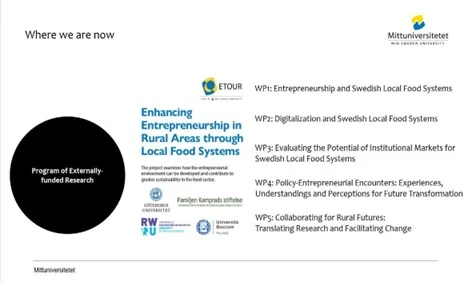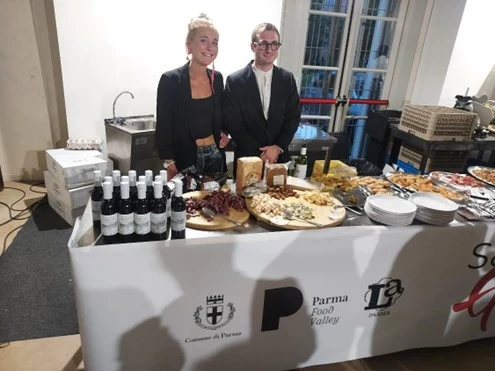Presentation of the project during Parmas UNESCO Creative City Network (UCCN) conference 19‑24 September 2024
The Kamprad project is further developing course activities based on its research results together with the University of Parma, Italy.
The project Enhancing entrepreneurship in rural areas through local food systems aims to promote the development of both scientific and applied knowledge on how to support entrepreneurship in local food systems. The project also aims to disseminate knowledge through conferences and meetings. During the course of the project, several opportunities have arisen where project participants have been able to link the project to other relevant contexts linked to rural development, entrepreneurship and food production.
One such unique opportunity was at the Parma UNESCO Creative City Network (UCCN) conference on 19-24 September 2024, which brought together researchers, practitioners and actors linked to the food sector at the University of Parma in Italy, a world-leading university and knowledge centre in the food sector.
At the meeting, the underlying ideas behind Enhancing entrepreneurship in rural areas through local food systems were presented, as well as interim results from the project, by Daniel Laven, Dag Hartman and Wilhelm Skoglund. The project's results will thus become part of and be included in the Winter School in Food City Design that the University of Parma and Mid Sweden University will run during the winter of 2024/2025 together with teachers and researchers at the University of California Los Angeles (UCLA).
The training will include elements of sustainable food production, food and health, tourism and gastronomy, highlighting examples of places that have successfully created or maintained vibrant and dynamic environments for local food systems. The training will also include field studies and collaboration with both large and small-scale food producers in Sweden and Italy. One of the elements of the training will be called Enhancing Entrepreneurship in Rural Areas through Local Food Systems and will be based on the research conducted in the project of the same name.

The project Enhancing entrepreneurship in rural areas through local food systems is central to Mid Sweden University's investment in the sector.
The meeting also planned for the joint development of an app by colleagues from Mid Sweden University and Parma University. The overall aim of the app is to provide the opportunity for users to create insight into their own eating habits, how healthy these are, as well as different opportunities to improve their eating habits through changing eating habits and healthy recipes, which in turn will be linked to regional food entrepreneurs. Thus, through the app, the intention is to improve opportunities for improved health and nutrition among users, as well as to create an opportunity for them to consume locally and sustainably. It also opens up an opportunity for local and regional food entrepreneurs to expand their customer base.

A mobile app is planned together with the University of Parma.
The event also included a well-attended cooking show by Signe Mogensen from Östersund, featuring Jämtland products from small-scale entrepreneurs, such as various cheeses, charcuterie and drinks. Guests then had the opportunity to taste and ask questions about Jämtland and Jämtlandic food. In this way, presentations of the research project and its results could be accompanied by food from the producers studied during the project. The products on offer included typical Jämtland dairy products and air-dried charcuterie.

Presentation and serving of Jämtland food to an Italian audience.
In addition, the Jämtland delegation also handed over products that will be offered in restaurants in Parma in the autumn of 2024. There was great interest in the Jämtland products and the Kamprad project representatives – together with Parma's UNESCO office and selected restaurateurs – will further develop the logistics of selling the products to retailers and restaurants in Parma and the surrounding area.
